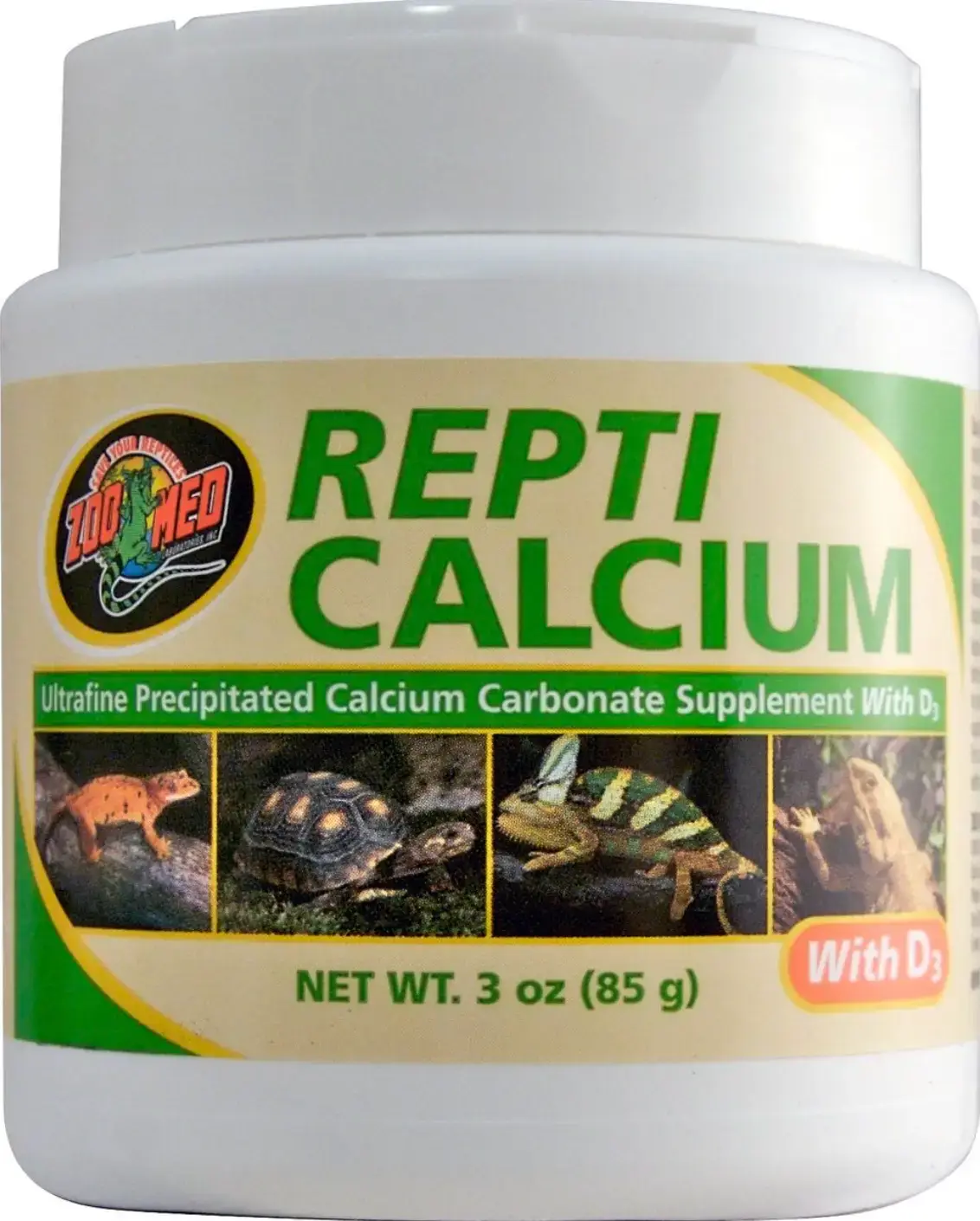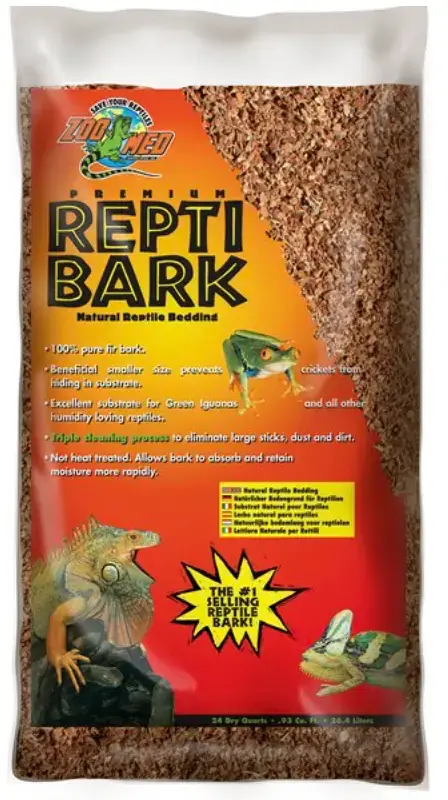This post contains affiliate links and I will be compensated if you make a purchase after clicking on my links.
Russian tortoises are great pets to have, but you may be wondering how big they get because you will need to take appropriate measures for their enclosure, and perhaps you want a specific size tortoise.
Captive-breed female Russian tortoises are 8 to 10 inches long as adults, while males are between 5 and 7 to 8 inches. Factors like diet, lighting, and habitat will also play a role in how large they get. Wild-caught Russian tortoises rarely exceed 6 inches as adults.
This article will dive deep into the Russian tortoise, providing you with facts on its size, consideration between the males and females, and insight into their habitat, diet, and more.
How Big Do Russian Tortoises Get?
As a hatchling, Russian tortoises will typically measure 1 inch in length (shell length) but will range between 5 and 10 inches in length when they have been raised to full adulthood.
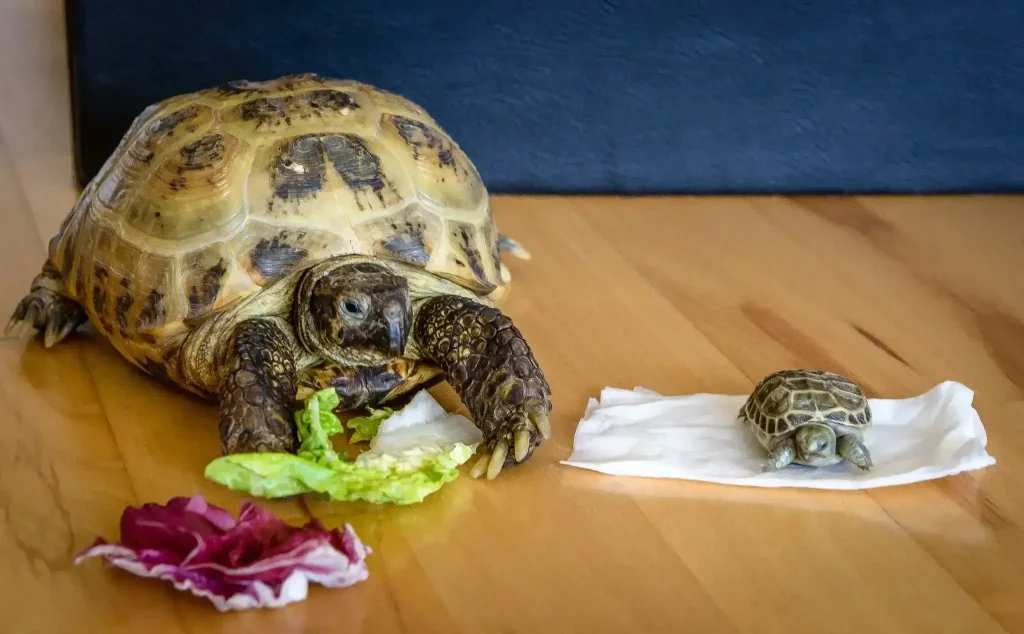
Many people (owners and professionals alike) indicate that the size of a typical adult is between 8 and 10 inches in length, but consideration of the fact that females are generally larger (longer) than males has to be accounted for, and, in fact, it is not uncommon for males to be 5 inches in length or longer.
In many cases, a male Russian tortoise may not surpass 6 inches.
Additionally, the factors (which we will discuss) that play a role in its growth will need to be taken into account, as these will play a prominent role in how large your Russian tortoise will actually grow over the course of its life.
Lastly, these measurements should only be regarded for captive-breed Russian tortoises due to the fact that Russian tortoises from the wild (wild-caught) rarely exceed 6 inches in length.
How Fast Do Russian Tortoises Grow?
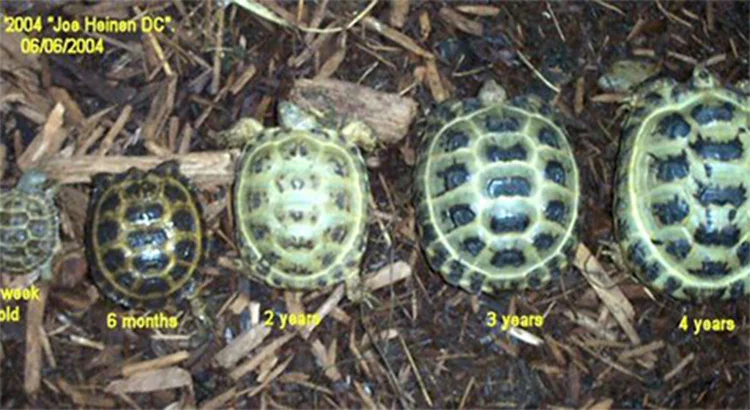
Over its lifetime, the growth of a Russian tortoise will be very slow.
However, as a hatchling that is approximately 1 inch in length (as stated), they will reach the size of 2 to 3 inches in a period of between 2 to 4 years, after which any further growth will come after many years.
How Long Does It Take For A Russian Tortoise To Reach Full Size?
Generally, growth is slow for any species of tortoise, taking many years, and although some species may reach seven inches in one year, a Russian tortoise will need decades to reach its fully grown adult size.
Considering that a fully grown Russain tortoise is between 5 and 10 inches in length, it can take them anywhere between 15 and 30 years to reach this size, becoming a fully grown adult and weighing up to two and a half pounds.
Take note that this is a long time (and somewhat a longer time than other species) since they already reach sexual maturity at age 10.
Russian Tortoise Size By Age Chart
| Russian Tortoise Age | Size (inches) | Weight (grams) |
|---|---|---|
| Hatchling (0 – 1 year) | Approximately 1 inch | Between 15 and 25 grams |
| Yearling (between 1 and 2 years) | Between 2 and 3 inches | Between 25 and 200 grams |
| Adult (Captive-Breed) | Males: Between 5 and 7 or 8 inches Females: Between 8 and 10 inches | Between 300 to 1500 grams |
| Adult (Wild-Caught) | Rarely exceeds 6 inches | Between 300 to 1000 grams |
The Size Difference Between Male And Female Russian Tortoises
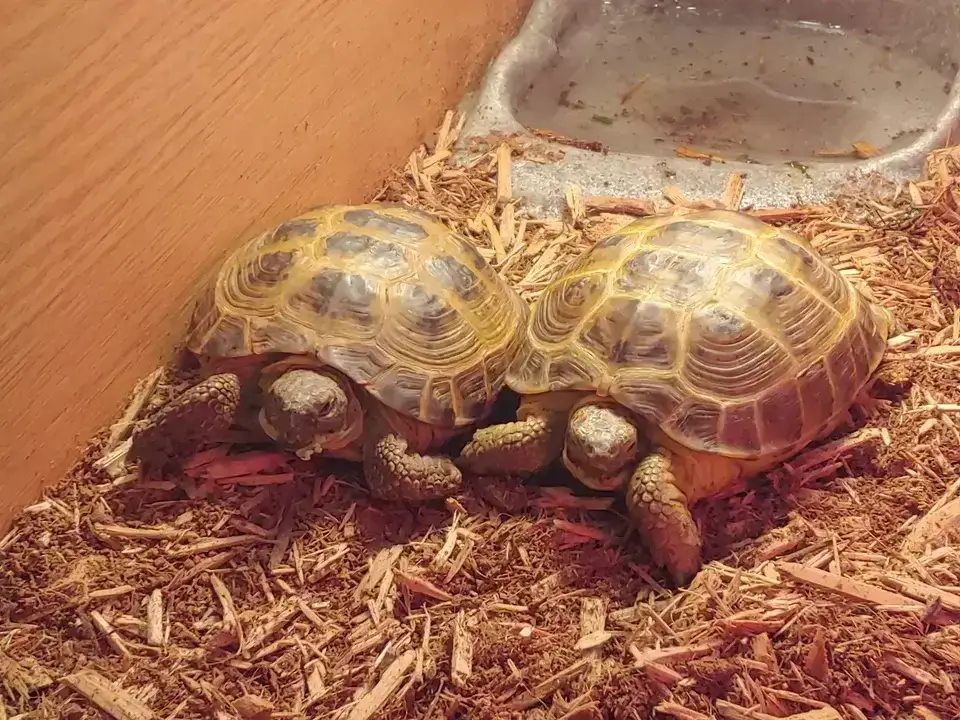
As we stated, female Russian tortoises are typically larger than their male counterpart.
Female Russian tortoises can sometimes be double the size of a male coming in between 8 and 10 inches as a fully grown adult.
Conversely, male Russian tortoises are typically between 5 to 7 (and 8 inches) in length.
The reason why females are larger is due to their needing to carry their offspring during pregnancy as well as to act as a deterrent against predators after birth.
Factors That Influence A Russian Tortoise’s Size & Growth
Although the average sizes for fully grown adult Russian tortoises were stipulated, many factors that we will now discuss will influence their growth rate and determine their adult size.
Take note that these factors will influence both male and female Russian tortoises.
Thus, if you plan to rear your Russian tortoise to its maximum size and keep it healthy, these elements should not be overlooked.
Diet and Nutrition
One of the main factors to consider if you want to raise your tortoise to its full potential size is its diet because not only will it not grow, but It will also cause stress, may cause disease, and even shorten its lifespan.
Russian tortoises are herbivores; thus, they will eat many leafy greens and plant-based foods. Some foods include;
- Lettuce
- Alfalfa hay
- Collard greens
- Corn
- Parsley
- Endive
- Spinach
- Dandelion greens
- Prickly pear cactus Chard
- Squash
- Turnip greens
- Broccoli
Expert Tip: You are more than able to feed your Russian tortoise commercial tortoise food and then supplement them every so often with these fresh vegetables.
Another Tip: Supplement your Russian tortoise’s food with calcium powder 2 to 3 times per week to keep them healthy and growing.
- Free of impurities such as Oyster Shell Calcium
- Great value for the amount of calcium you're receiving
- Free of impurities such as Oyster Shell Calcium
Gender
No matter if the living conditions for your tortoise are perfect, their gender will always determine how large they will get.
As stated, males will always be smaller (between 5 and 7 or 8 inches) than females (between 8 and 10 inches).
Take note that if the living environment is not acceptable such as the UVB lighting and diet, then you can expect them not to reach these sizes, or their growth will be drastically slowed.
If you would like to know how to determine your Russian tortoise’s sex (male or female), check out the how-to video below.
Hibernation
Consider that not all species of tortoises hibernate, although Russian tortoises tend to do so at times and are in a state of “long-term dormancy”(to a degree).
Moreover, Russian tortoises between the ages of 3 and 5 may not hibernate if the temperatures are moderate.
Expert Tip: When kept indoors, hatchlings do not need to hibernate and can withstand temperatures at night that go into the low 50s.
Then if your Russian tortoise is kept outdoors, it will typically hibernate in winter.
They will only do this if they are able to dig and burrow before the cold sets in.
Typically, you will find that hatchlings and yearlings that hibernate will do so between 8 and 10 weeks, and although adults will hibernate for longer, they will not exceed 16 weeks.
Take note that hibernation is a strategy that animals employ in order to withstand the winter, and their bodies go into a state of dormancy.
This means that their heart rate, breathing, and metabolism slow down; if they do grow (at all), it will be at a very slow pace.
Health
Your Russian tortoise’s health will play a big role in determining its fully grown size.
Take into consideration that diet, lighting, and their environment, along with any sickness, will contribute to their well-being.
UVB Lighting
You may not know this, but UVB light plays an enormous role in a Russian tortoise’s development and growth due to this type of light aiding in vitamin D production.
This allows your tortoise to absorb calcium from their food and supplementation.
Calcium is responsible for a healthy shell and strong bones in your Russian tortoise; without it, stunted growth and a rubbery shell may occur.
Take note that your UVB light should be on for 10 to 12 hours daily. The recommended UVB light for a Russian tortoise is a T5 HO lamp.
- High-output tortoise lamp
- Claw-fect for larger tortoise habitats.
- Crafted to put out stronger and brighter UVB light.
Additionally, using a 10% (10.0) can also be considered as long as the light is around 15 to 20 inches away from the shell.
12% lamps may also be used, but these should be mounted approximately 24 inches away due to it providing a greater output and more coverage.
Bonus Tip: If you plan to house your Russian tortoise outdoors, then there is no need to worry about a UVB light because this will be provided by the sun.
Habitat
Habitat is the last factor to consider and is also a determinant factor contributing to your Russian tortoise’s growth.
They thrive, flourish in dry, open areas, and keep in sandy locations. Additionally, they will need access to higher humidity of between 40 and 75%. This is so that they can stay hydrated.
This means that If you want to house them indoors, you will need to at least consider purchasing a humidifier (if you live in a dry region) and then substrate.
A substrate is the “bedding” that you will use to line the floor of your tortoise enclosure. This is what they will use in order for them to dig and burrow when they need to.
Moreover, the substrate provides an additional way for them to keep hydrated by absorbing water from it.
- Made from natural fir bark
- Suitable for burrowing
- Can be washed and reused
Expert Tip: If you plan to house your Russian tortoise outdoors, then keep in mind that artificial grass can be used as long as they have a place to burrow.
How Much Space Do Russian Tortoises Need?
Due to their size, Russian tortoises require a minimum enclosure of 4 X 3 to 4 feet.
Note that this is a determined size for one adult Russian tortoise, and you will need an 8 X 4 feet enclosure to house two adults (one female and one male).
Indoor Enclosures
You have many options available for indoor enclosures, and a plastic tub, wooden terrarium, or glass tank will all suffice.
Note that although the minimum requirements for space that are the best for well-being and growth were stated, if need be (due to space limitations), a 5-square foot enclosure may be used.
Check out this great Indoor Tortoise Enclosure
- It is suitable for outdoors and indoors
- Easy to assemble
- It has a frame for lighting
Expert Tip: If you plan on purchasing a second Russian tortoise (for whatever reason) down the line, then it would be better and cheaper to purchase a larger enclosure at the start.
Outdoor Enclosures
Outdoor enclosures should always be constructed or bought with the minimum recommended size in mind.
Additionally, the walls of the enclosure should be at least 1 foot tall and approximately 6 inches deep.
Lastly, it is highly recommended that a section of the enclosure is shaded so that they are able and can adequately regulate their body temperature.
Tip: Even if you house your Russian tortoise outdoors, it may be easier in terms of time spent and money to consider purchasing a wooden enclosure that will be resistant to the elements.
Difference Between Pet And Wild Russian
Consider that the growth rate of tortoises is typically accelerated when bred and held in captivity.
This is further confirmed by the fact that a wild-caught Russian tortoise typically does not exceed 6 inches in length, while their captive-bred counterparts can reach up to 10 inches as adults.
FAQs
How Can I Make My Russian Tortoise Grow Faster?
It would be best to understand that Russian tortoises take years to grow and already have an accelerated growth rate in captivity.
Moreover, it is not healthy for tortoises to grow or gain weight at a speed that is faster than what is normal.
On average, a healthy Russian tortoise should gain approximately 1 to 4 grams of weight per month.
How Can I Tell If My Russian Tortoise Is Overweight Or Underweight?
To determine whether your tortoise is under or overweight, you would calculate its BMI (Body Mass Index).
The formula for this is your tortoise’s current weight divided by the target weight.
To go into detail on how exactly this formula should be considered and what the appropriate weights are is beyond the scope of this article, but a reference sheet and detailed explanation can be found here.

